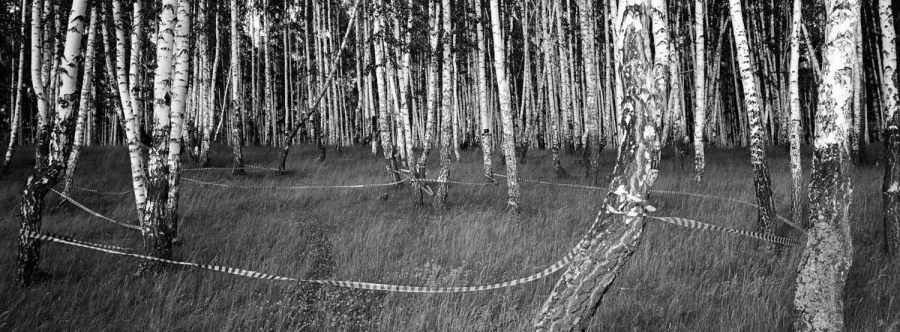On December 18th, one of the gravest problems of today’s Russia—corruption—was visualized and discussed in New York’s Half King bar where Misha Friedman, an up-and-coming New York photographer, presented his recent works at a preview of his Photo 51 Project. He was joined by Peter Klebnikov, Chief Editor at the Environmental Defense Fund, and Anna Van Lenten, co-curator of photography series at Half King. The Photo 51 Project is sponsored by the Institute of Modern Russia; it will premiere on February 15th at 287 Spring Gallery in New York.

Just outside the “closed city” of Snezhinsk (Chelyabinsk Region), a group of teenagers marked off their camp site with caution tape. Severe limits on private property in the Soviet Union made Russians prone to staking and fencing off anything they deem their own. Even years after the fall of the Soviet Union, such paranoia still governs much of daily life.
In an introduction to the slideshow of his photographs, Misha Friedman explained why the project is entitled Photo 51. Originally, Photo 51 was a nickname for the first X-ray diffraction image taken in 1952 that provided a breakthrough for researchers trying to model the structure of DNA. In today’s Russia, corruption has penetrated to the very core of society, at every level of people’s lives and daily routines, and, metaphorically speaking, became a part of Russia’s DNA.
“When I began this project, the key problem was how to visualize corruption. There are basic symbols, but I was not after the obvious,” Friedman said. “I went on several trips to Russia – to St. Petersburg and Moscow, to little towns of Karelia and the Urals. Once there, it took no more than a drive or a walk to see that corruption [is] manifested everywhere.”
The problem, as Friedman explained, is that most Russians don’t acknowledge that corruption has become a Russian institution, upon which all other institutions run. “Business, education, police, military, medical and judicial operations don’t happen without patron-client transactions. And while this state of affairs has always ruled, since Putin came to power, the government’s grip in all arenas has ensured that corruption is coded into the entire state and civic apparatus.” As Friedman pointed out, the blame belongs not only to bribery itself, but also to the acceptance of this situation in society.
In the last 10 years, corruption in Russia has been going viral at all levels—government, business, public and personal.
In the course of the slideshow that followed, Peter Klebnikov observed that the content of Friedman’s photographs projects a sense of deep misery: a Russian forest where thousands of GULAG prisoners were executed; a former NKVD building that now serves as a market; a medical committee for the army for draft-age men; a scene of street violence; a city jail adjacent to an apartment building; a village polluted with nuclear waste; and, of course, the infamous Russian roads. “It’s a landscape of decay, and the depicted sites are symbols of a failed state,” Klebnikov said. Referring to the fact that most Russians are in denial about the disastrous state of affairs in their country, he added that dignity is easy to lose, but the person who lost it is the last to know.
The Photo 51 Project is a part of IMR’s efforts to raise awareness of the devastating effect corruption has on Russia’s state and society. In the last 10 years, corruption in Russia has been going viral at all levels—government, business, public and personal. Reports from Transparency International indicate that Russia's ranking on the Corruption Perception Index has fell from 71 (out of 102 countries) in 2002 to 133 (out of 172 countries) in 2012. One of the underlying reasons for this dismal statistic is that people have gotten too familiar with the phenomenon. Having to deal with corruption on the daily basis has almost made it a societal norm. Although fighting corruption at the governmental and institutional level is a necessary step, Russian citizens mist also understand the connection between their own actions and the decaying of their country. Misha Friedman's works help visualize that link.








